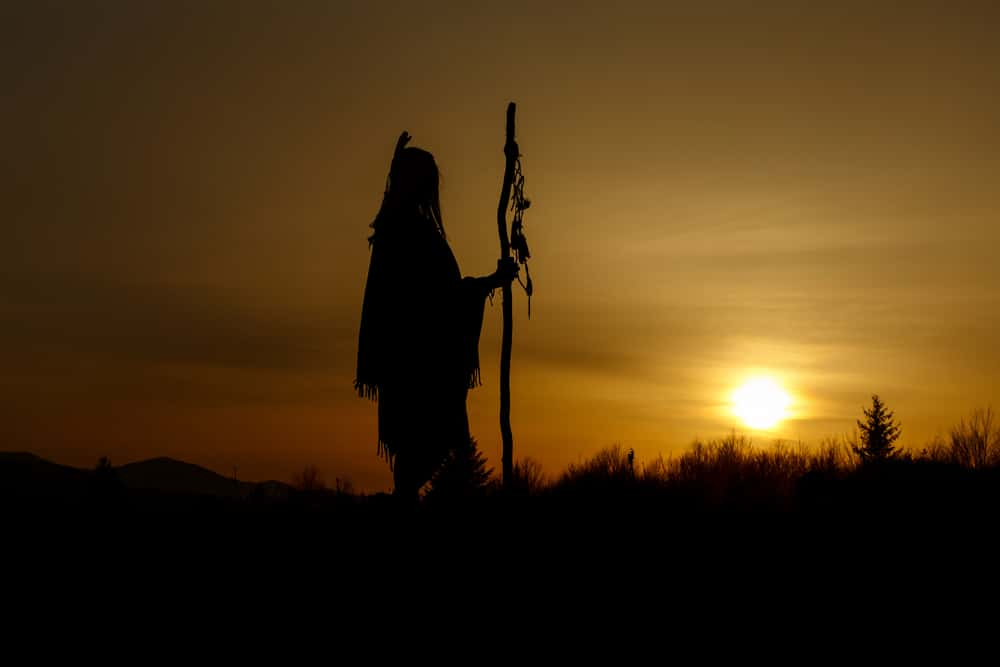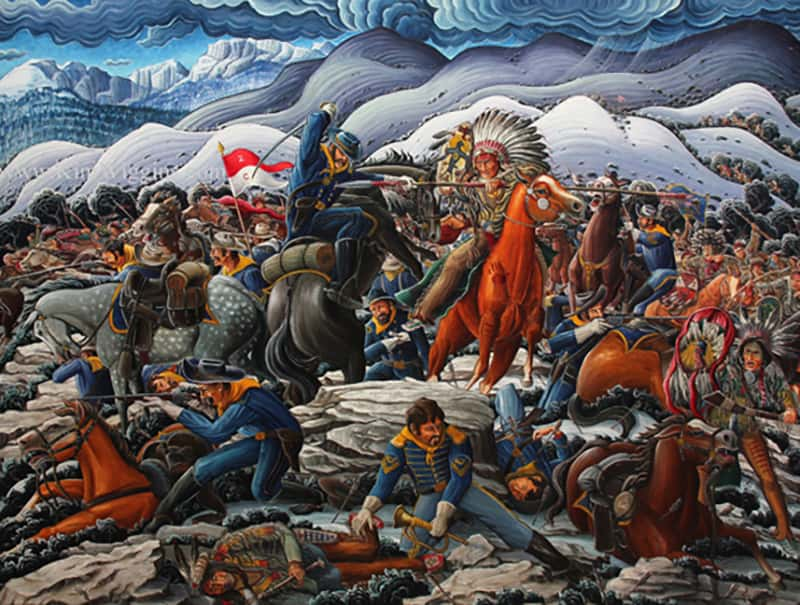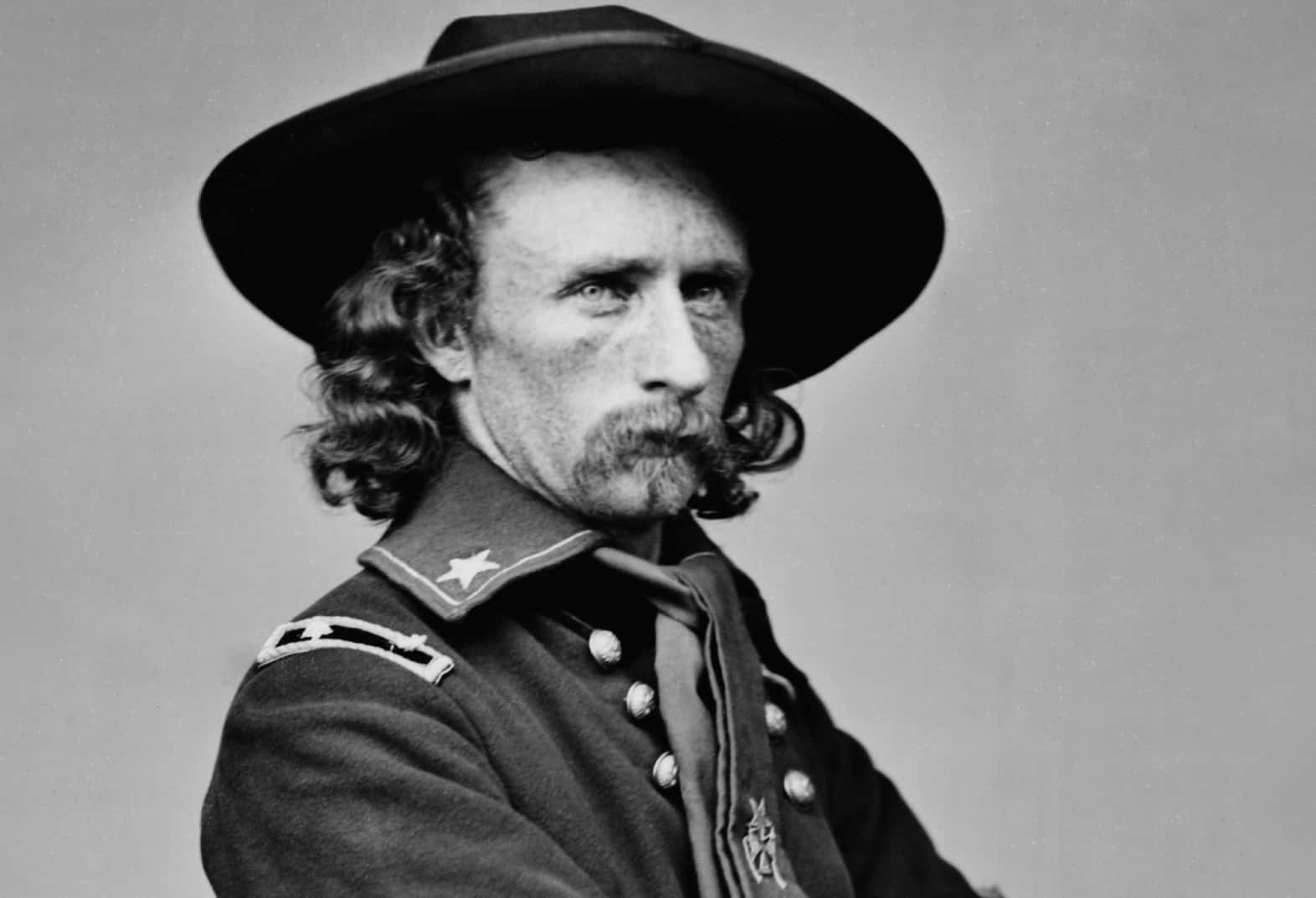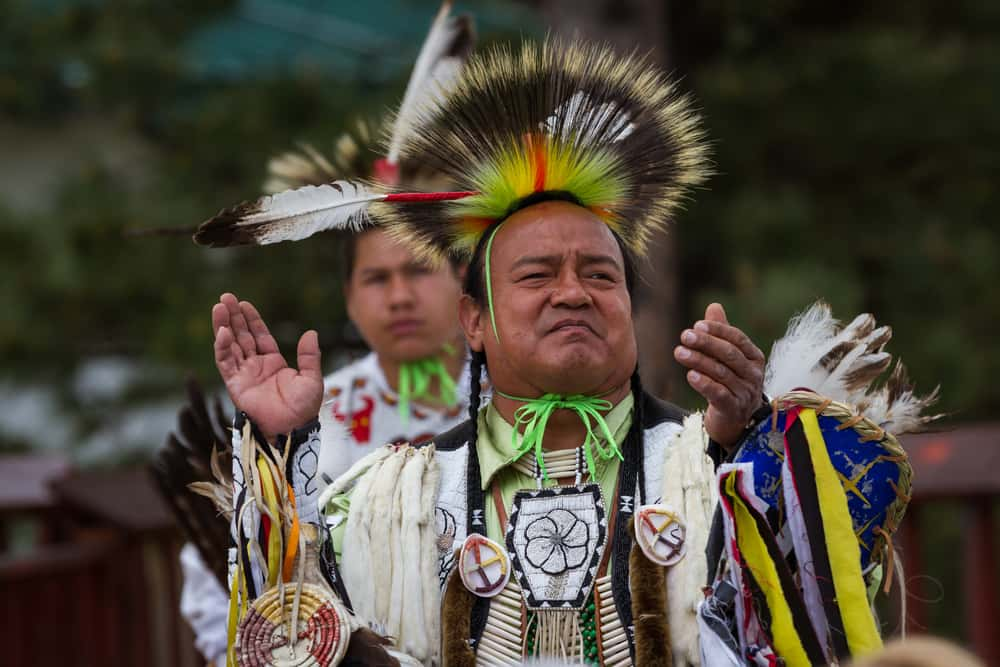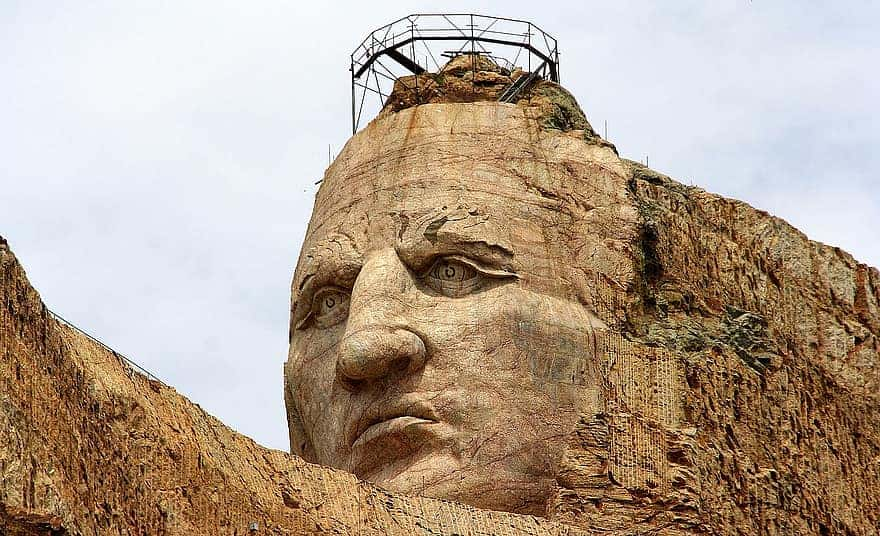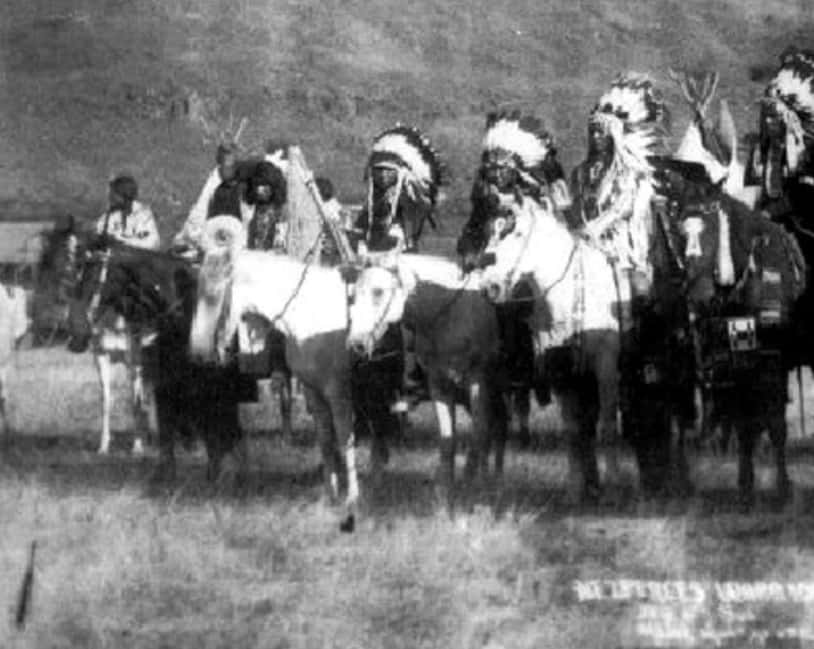Hailed now as a hero for his people, a fearless leader, and a good man, Crazy Horse lived and died as an enemy of the US government. His name is legendary, but what do you really know about the man behind the myth? There was more to his life than the history books want you to know. Let’s look back and discover why the name Crazy Horse means so much today.
1. Nobody Knows When He Was Born
No one knows the exact year Crazy Horse was born. According to his close friend and tribesman, He Dog, he was born in 1842. However, other sources seem to indicate he was born in 1840. The general consensus is that he was born somewhere between 1840 and 1845, and it didn't take long before he rose to prominence among his people.
2. He Wasn’t the Original “Crazy Horse”
Cha-O-Ha, which meant “Among the Trees,” was Crazy Horse’s original name when he was born. It was his father, an Oglala shaman, who had originally inherited the name Crazy Horse, from his own father. He transferred it to his son a few years after his birth, changing his own name to “Waglula,” which meant “Worm.” Clearly, he didn’t subscribe to the “what’s in a name?” idea.
3. His Mother Called Him Curly
Crazy Horse was Waglula's only child with his wife Rattling Blanket Woman, who was from another Lakota band known as the Miniconjou. She affectionately called her son “Curly” or “Light Hair,” because his light, curly hair was unusual in their tribe. Sadly, a tragic misunderstanding led to Crazy Horse losing his mother all too soon.
4. But She Wasn’t Around for Long
Curly, or Crazy Horse as he became better known, was only four when his mother hanged herself. She hadn’t been able to have another child, and she thought Waglula didn’t want her in his life anymore, so she ended her own. What gave her that idea? Why, just the fact that Waglula came home from a hunting trip with three new wives!
5. His Father Was Heartbroken
The most tragic part of Rattling Blanket Woman's death was that she was wrong: Waglula still loved her, and hadn't actually abandoned her. While buffalo hunting, he ended up saving a village under attack by another tribe. The village's chief gave Waglula his three daughters as a token of his gratitude. He had no plans on replacing Rattling Blanket Woman.
Her passing devastated him, and he mourned her for four years. Meanwhile, Rattling Blanket Woman's sister, Good Looking Woman, took over Crazy Horse’s upbringing.
6. A Brawl Changed Him
When Crazy Horse was a young boy, he witnessed an incident that changed him forever. A white officer, John Grattan made his way to Crazy Horse's camp and demanded compensation for his “stolen” cow. This was a cow that had wandered into the camp earlier, and someone had butchered it to share its meat with everyone. Unfortunately, this act ended up having dire consequences...
7. The Brawl Didn’t End Well
Crazy Horse saw Grattan get really angry when no one acknowledged him. He signaled his officers to open fire at the Lakota. The result was devastating: Conquering Bear, the chief, was fatally wounded. The Lakota retaliated and brought down Grattan and all 29 of his men. The day was horrifying—but it dawned on Crazy Horse that this wasn’t a one-off event.
8. He Mistrusted the White Man
The Lakota were the biggest tribe of the Sioux people, and had lived peacefully on their land until the 1850s. White settlers started making their way into the Great Plains, and they brought ruin with them. Though still young, Crazy Horse understood that these people threatened his tribe’s lifestyle and livelihood.
He was right to be afraid: The Grattan conflict he’d witnessed became the forerunner of the First Sioux War, between the United States and the Lakota.
9. He Needed a Vision
Crazy Horse felt disturbed after the conflict. Ancient Lakota tradition dictated that a young man may seek a vision to help him fulfill his destiny. Around this time, Crazy Horse started to get fleeting visions, but had to follow the Lakota custom of not eating or drinking for four days to confirm them. He then went on a vision quest with father, Waglula.


History's most fascinating stories and darkest secrets, delivered to your inbox daily.
10. And He Got It
Father and son sat in an isolated spot in the hills, in modern South Dakota, for their hemblecha, or vision quest. In his vision, Crazy Horse saw a dancing, swaying horse and a simply dressed warrior with a feather on his head. The man had a lightning bolt on his cheek and hailstones painted on his body. The warrior told Crazy Horse to live simply and to never take any scalps or war trophies in battle.
If Crazy Horse followed this creed, so said the warrior, no harm would come to him. Unfortunately, this prophecy wouldn't come to pass...
 Crazy Horse (1996 TV Movie), Turner Pictures
Crazy Horse (1996 TV Movie), Turner Pictures
11. And He Believed It
Crazy Horse’s vision had shown him the Southern world, where the Lakota believed spirits went in the afterlife. Many believed this was the secret of his success. In battle, he would just imagine being in that world again, allowing him to fight without the fear of the end. He also emulated the warrior he’d seen, copying his style of face paint and refusing to wear traditional headgear.
Crazy Horse took no trophies in battles and remained silent about his exploits. It seemed as though the words of his vision were coming true—even in the midst of serious fighting, Crazy Horse always managed to escape unharmed. Well, until the end…but more on that later.
12. He had a Magic Stone and a Beloved Horse
A medicine man called Horn Chips once gave Crazy Horse a black stone. He claimed the stone would protect its bearer from bullets. Crazy Horse put the stone behind his beloved horse’s ear, so they could be one in battle. The horse, in case you’re wondering, was a black-and-white pinto called Inyan (which means “rock”).
 Crazy Horse (1996 TV Movie), Turner Pictures
Crazy Horse (1996 TV Movie), Turner Pictures
13. He had a Strong Sense of Justice…
Not only was Crazy Horse utterly fearless, but he also believed in justice. When he found that a Shoshone man had taken the life of a Lakota woman, he set out for vengeance. He caught up to the killer and repaid him in kind. This was the first time he took a life—but it wouldn't be the last.
 Crazy Horse (1996 TV Movie), Turner Pictures
Crazy Horse (1996 TV Movie), Turner Pictures
14. His Bravery Won Him Honor
The Lakota allied themselves with the Cheyenne and Arapaho tribes and decided to take up arms against the United States Army. Crazy Horse played an important role in both the Battle of Platte Bridge and the Battle of Red Buttes. His fighting skills, kindness, and strength won him the title of “Shirt Wearer,” which meant leader.
15. He Helped Win a Major Battle
He wasn’t Shirt Wearer for nothing. Crazy Horse was no fan of the government’s plan of encroaching their tribal land, so when he learned that they wanted to build a road to the goldfields in Montana, he was at the forefront of the resistance. The idea was to plant decoys on the officers’ route and lure them towards their doom. Crazy Horse grimly put the plan into action, and it worked like a charm.
 Crazy Horse (1996 TV Movie), Turner Pictures
Crazy Horse (1996 TV Movie), Turner Pictures
16. And Banished the Opponents…For a While
Captain William Fetterman, who was leading 80 men from Fort Kearny, fell for the trap and walked into the ambush. The event became known as the “Fetterman Fight,” though the Native Americans called it the “Battle of the Hundred-in-the-Hands.” It ended badly for the Americans: None of them survived the attack. It was the US Army's worst defeat at the hands of the Native Americans up to that point—and there was more bloodshed to come.
17. He Tried to Repeat His Success
After their successful campaign against Capt. Fettermen, Red Cloud and Crazy Horse led their people to another attack; this time against the officers stationed near Fort Kearney. But while the Fetterman Fight was a victory, this plan ended in disaster. They’d hoped to use the same decoy trick they had used for Fettermen’s army, but the officers got wind of their plan and took refuge in some wagon boxes. Although Crazy Horse's warriors outnumbered their opponents, the latter had something they did not…
18. And Learned a Lesson the Hard Way
The Americans had fast-shooting rifles called breechloaders, while the tribesmen mainly just had bows and arrows. Crazy Horse's forces retreated after some hours of fighting, when more officers came to defend their unit. The engagement came to be known as the Wagon Box Fight. The difference in casualties was huge: Anywhere from 50-120 for the Native Americans, and only five for their opponents.
Crazy Horse realized the futility of charging against white men in “a strong defensive position,” and this became the last such charge he ever led. Wyoming has since designated the location of the Wagon Box Fight as a historic site, with a plaque explaining the details of the engagement.

19. He was a Popular Leader
Maybe Crazy Horse wanted to follow the advice the warrior in his vision had given him. Maybe it was just how he was. Either way, Crazy Horse's people soon knew him as a quiet and reserved person who was generous to a fault. He was fearless in battle and always led from the front. He was very protective about his people’s way of life, and he proved time and time again that he was willing to do whatever it took to preserve it.
 Crazy Horse (1996 TV Movie), Turner Pictures
Crazy Horse (1996 TV Movie), Turner Pictures
20. And Another One with a Happy Ending
A woman named Black Shawl came to take care of Crazy Horse after a painful injury and ended up becoming his wife. However, their marital bliss would quickly be shattered by tragedy.
21. He Had One Daughter
Crazy Horse didn’t leave behind a large family. He only had one daughter with Black Shawl, whom they named They Are Afraid of Her. In a heartbreaking turn of events, the girl fell terribly ill when she was just a toddler. She succumbed to her illness at just three years old.
22. He had a Loyal Friend
Crazy Horse's people adored him, and he had many faithful friends who cared about him deeply. Touch the Clouds, his cousin, was one such friend. The men often rode together in battles and hunts, and Touch the Clouds even reportedly saved Crazy Horse's life at one point. A jealous man caught Crazy Horse with his wife and shot at him. The man would have put an end to him if Touch the Clouds hadn’t knocked his hand away in the nick of time!
23. He Gained a Title…And Lost It Too
The title of “Shirt Wearer” was a great honor, and Crazy Horse received it because of his daring exploits and fearlessness in battle. Basically, it meant that everyone accepted him as their leader. Unfortunately, Crazy Horse wasn't perfect, and his behavior eventually led to the elders stripping him of his title—not that he let that stop him.
24. He had Another Wife
Records show that Crazy Horse had another wife: Nellie Larrabee, the child of a French trader and a Cheyenne woman. Red Cloud sent Larrabee to Crazy Horse, but she may have had more sinister motives. Many believed the US Army had sent her to act as a spy. There are accounts describing her as an “evil and insidious woman” whose manipulations led to Crazy Horse’s destruction.
There is no more detail about the manipulations though, so we may never know what her true motivations were.
25. He Just Wanted Them to Leave Him Alone
All Crazy Horse wanted was for the Americans to leave his people be so they could live according to their traditional ways. For a moment, it seemed like he was going to get his wish. In 1868, the government signed the Treaty of Fort Laramie. The landmark accord gave the Sioux control of the Black Hills of South Dakota. Alas, it wasn’t meant to be.
26. But That Didn’t Happen
Soon after the treaty, prospectors found gold in the Black Hills, so the government pushed the Sioux to sell the land to them. Naturally, they refused—but the US government rarely takes no for an answer. Instead, they ordered the Sioux to leave and move to smaller reservations. As you can imagine, this about-face did not impress Crazy Horse.
 Crazy Horse (1996 TV Movie), Turner Pictures
Crazy Horse (1996 TV Movie), Turner Pictures
27. He Fought Against Crook
One of the greatest charges Crazy Horse ever led was at the Battle of Rosebud. As Brigadier-General George Crook marched to force the Native Americans to the reservations allocated to them, the Lakota and Cheyenne warriors, led by Crazy Horse, took him by surprise. The Native Americans fearlessly drove Crook and his men back to their camp in Wyoming—but it wasn't easy.
28. He Didn’t Back Down
The Lakota-Cheyenne partnership was strong, in large part because they had a leader like Crazy Horse who was unwilling to back down. In fact, at over six hours, the Battle of Rosebud became known as the longest and bloodiest engagement between the Sioux and the Americans. An officer, Captain Mills, called Crazy Horse and his warriors the “best cavalry soldiers on earth.”
29. And This Helped Him in Another Battle
Not only did Crazy Horse’s tactics force Crook and his men to withdraw to their camp, they also made him unable and unwilling to proceed to Little Bighorn. This meant they were not there to help Lieutenant Colonel George Custer, whom the government had sent to round up and relocate the Sioux to the reservations. The result: A decisive victory for Crazy Horse at the Battle of Little Bighorn, one of the biggest military disasters in US history.
30. His Last Battle Was His Greatest Fight
The government had estimated that Crazy Horse had at most 800 warriors with him. That's the number Custer expected to face at Little Bighorn. Unfortunately for him, many of the Native Americans who had already left for the reservations had returned to join and help their “hostile” cousins. Custer's men stood no chance against the 1,000-1,500 warriors who arrived.
The Americans faced severe casualties in a fight that lasted under an hour. Infamously, Custer himself lost his life in the fray.
31. His Bravery Was Legendary
Several accounts from his fellow tribesmen describe Crazy Horse’s legendary fearlessness in battle. He rode close to the white officers and braved their bullets, while encouraging his men to keep fighting. He escaped without a scratch, despite the fact that so many men were aiming at him. His surprise attack “overwhelmed the cavalrymen…causing a breakdown in command structure.”
 Crazy Horse (1996 TV Movie), Turner Pictures
Crazy Horse (1996 TV Movie), Turner Pictures
32. He Attended the Last Sundance
The Sun Dance is one of the biggest and most important religious festivals for the Native Americans of the Great Plains. In 1877, a year after the Battle of Little Bighorn, Crazy Horse attended the festival for the last time. The tribes held the festival to honor and pray for him, but he did not take part in the dancing himself.
33. And Saw the Sacrifices Made for Him
At the Last Sun Dance of 1877, five of Crazy Horse’s cousins and followers offered sacrifices of their flesh and blood for his continued health and safety. All of these men were brave, upstanding, loyal men who had fought heroically alongside him in several battles.
34. But Things Changed
The Battle of Little Bighorn became the last decisive battle in the Great Sioux War. Although the Native Americans won that round decisively, they couldn't stop the US government in the long run. Their policy of depleting the buffalo herds and raiding Sioux camps and villages was effective, and pretty soon, Crazy Horse's people found themselves on the brink.
35. He had to Accept It
Some of Crazy Horse’s fellow leaders, like Chief Gall and Sitting Bull, who’d fought alongside him at Little Bighorn, moved to Canada not long after. Crazy Horse remained, but after facing a winter of hardship and very little food, he was finally forced to make a heartbreaking decision—one he knew was essential to protect his people.
36. He Surrendered
In 1877, Crazy Horse surrendered to the government, and they took him to a reservation in Fort Robinson, Nebraska. This was a huge deal for the Americans. Both George Crook (remember him?) and Colonel Miles wanted credit for his surrender. They each sent him messages promising fair treatment, along with gifts of food. Crazy Horse eventually ended up surrendering to Crook, who sent Crazy Horse's own uncle, Spotted Tail, to act as an emissary.
37. He Was Camera Shy
Unassuming and self-effacing by nature, Crazy Horse did not like being photographed. Although there are some pictures of him, there is no way of confirming their authenticity. In fact, most experts believe that no photograph of him exists.
38. He has a Memorial
South Dakota is home to Mount Rushmore, with faces of past American presidents chiseled into the granite face of the mountain. Considering this a gross unfairness to the people who originally lived on the land, a Lakota elder and a Polish-American sculptor decided that the world needed to see a Native American hero’s sculpture to understand their side of the story. And who was a bigger hero for the Lakota than Crazy Horse?
39. Which is Hard to Miss
Thus far, only Crazy Horse’s face has been carved into Thunderhead Mountain, even after 71 years of hard work. The original sculptor, Korczak Ziolkowski, envisioned it as a huge monument, depicting Crazy Horse on his steed. Unfortunately, he passed before completing the face, and it fell to his wife, Ruth, to finish it off. The sculpture’s unveiling was in 1998 and it has since prompted a huge wave of tourism, with over a million people visiting the site each year.
40. And has Prompted Mixed Reactions
It was meant to be a monument to honor him, and many of his Lakota descendants are grateful to have a symbol of their history carved in stone for the world to see, but there are also a number of people who consider the huge sculpture a mockery of Crazy Horse’s ideals and of the humble, self-effacing person he was. Also, many have pointed out the irony in sculptors blowing up the land he fought to protect so they could carve his face into it.
41. There is a Stamp in His Name
The government of his time may have had a lot of problems with him, but in 1982, the US Postal Service honored Crazy Horse with a 13 cent Great American Series postage stamp. He has also been named as one of the most “notable and iconic” Native American warriors in history.
42. The Other Chiefs Were Jealous of His Popularity
When Crazy Horse rode to Fort Robinson with his friends and followers, the procession stretched for two miles. The Lakota all hailed him with songs, cheers, and applause. An army officer who witnessed his arrival called it more of a “triumphal march” than a surrender. Unfortunately, this their made older leaders like Red Cloud and Spotted Tail jealous—and this jealousy would have devastating consequences...
43. And the Officers Didn’t Trust Him
The army officers mistrusted Crazy Horse because of his popularity. They didn't believe he would keep the peace, although that's exactly what he intended to do. He had made a promise to the “Great Spirit” that he wouldn’t fight anymore. However, the officers pushed him to help them catch some warriors from the Nez Perce tribe who had escaped from the reservation—and they wouldn't take no for an answer.
44. They Misunderstood Him
Tired of their constant pressure, Crazy Horse agreed to fight “until there wasn’t a Nez Perce left.” He didn't realize it at the time, but he would come to regret those words. A vengeful interpreter named Grouard deliberately changed Crazy Horse's message, writing that he would fight "until there wasn't a white man left." At the same time, Red Cloud had already planted doubt in Crook’s mind, telling him Crazy Horse wanted him dead.
Convinced that Crazy Horse had gone rogue, Crook ordered his detention—and that was only the beginning.
45. They had Decided His Fate
Meanwhile, Crazy Horse had left his reservation for a new one, bringing with him a very sick Black Shawl. All he wanted was a peaceful existence—but sadly, that wasn’t meant to be. The government remained convinced of his hypocrisy and wanted him behind bars.
 Crazy Horse (1996 TV Movie), Turner Pictures
Crazy Horse (1996 TV Movie), Turner Pictures
46. But There Was an Unexpected Ending
When Crazy Horse heard about all the rumors, he panicked. Sure of his innocence, he returned to Fort Robinson to try and explain himself—but he was only marching to his own doom. The officers there had already decided his fate. Upon arrival, guards captured Crazy Horse and tried to discreetly lead him to a cell.
When Crazy Horse realized what was happening, he struggled and tried to escape. In the confusion, a guard pierced him in the back with his bayonet.

47. He Stuck to His Ideals til the End
Crazy Horse’s long-time friend and cousin, Touch the Clouds, was with him in his last moments. The guards took him to an adjutant’s office, but showing his customary spirit, the Crazy Horse refused to be put in “the white man’s cot.” He succumbed to his injuries on September 5, 1877. He was not yet 40 years old.
48. Did He Wield the Knife?
There is more than one version of how Crazy Horse got his fatal injury. Little Big Man, who was also there on that fateful day, claimed that Crazy Horse drove the knife into his own back when he realized what was happening. This theory does not seem likely, however. Not not only was Little Big Man one of Crazy Horse's fiercest rivals, but he was also the only one out of 17 eyewitnesses to make this claim.
49. He had an Unrequited Love Story
The first love of Crazy Horse's life, Black Buffalo Woman, caused him no end of trouble. Why? Because was a married woman! Well, to be fair, she was single when he fell in love with her, but of course he refused to give up on her even after she married No Water. The girl couldn’t resist Crazy Horse's wiles and agreed to run away with him. But these two lovers didn't plan on one thing...
Black Buffalo Woman's furious husband followed the fleeing couple. He eventually caught them and ended up shooting Crazy Horse in the face. Thankfully, the bullet only grazed his jaw, but the scar stayed with him for the rest of his life.
 Crazy Horse (1996 TV Movie), Turner Pictures
Crazy Horse (1996 TV Movie), Turner Pictures
50. His Burial Site is a Mystery
After his passing, Crazy Horse’s elderly parents took his body. They erected a scaffold grave for him at Camp Sheridan and moved his remains to an undisclosed location after a few days. To this day, no one knows where Crazy's Horse's final resting place is.




